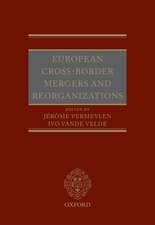Corporate Manslaughter and Regulatory Reform: Crime Prevention and Security Management
Autor P. Almonden Limba Engleză Hardback – 17 ian 2013
| Toate formatele și edițiile | Preț | Express |
|---|---|---|
| Paperback (1) | 635.65 lei 6-8 săpt. | |
| Palgrave Macmillan UK – 2013 | 635.65 lei 6-8 săpt. | |
| Hardback (1) | 641.71 lei 6-8 săpt. | |
| Palgrave Macmillan UK – 17 ian 2013 | 641.71 lei 6-8 săpt. |
Din seria Crime Prevention and Security Management
- 17%
 Preț: 361.49 lei
Preț: 361.49 lei -
 Preț: 348.39 lei
Preț: 348.39 lei -
 Preț: 486.60 lei
Preț: 486.60 lei -
 Preț: 382.18 lei
Preț: 382.18 lei -
 Preț: 391.22 lei
Preț: 391.22 lei -
 Preț: 418.45 lei
Preț: 418.45 lei -
 Preț: 390.25 lei
Preț: 390.25 lei -
 Preț: 419.21 lei
Preț: 419.21 lei -
 Preț: 384.31 lei
Preț: 384.31 lei - 18%
 Preț: 727.18 lei
Preț: 727.18 lei -
 Preț: 383.93 lei
Preț: 383.93 lei - 15%
 Preț: 638.89 lei
Preț: 638.89 lei - 18%
 Preț: 952.09 lei
Preț: 952.09 lei -
 Preț: 389.70 lei
Preț: 389.70 lei - 15%
 Preț: 516.15 lei
Preț: 516.15 lei -
 Preț: 392.60 lei
Preț: 392.60 lei -
 Preț: 383.71 lei
Preț: 383.71 lei - 15%
 Preț: 702.87 lei
Preț: 702.87 lei - 15%
 Preț: 643.99 lei
Preț: 643.99 lei -
 Preț: 453.60 lei
Preț: 453.60 lei -
 Preț: 391.61 lei
Preț: 391.61 lei - 18%
 Preț: 788.54 lei
Preț: 788.54 lei -
 Preț: 395.85 lei
Preț: 395.85 lei -
 Preț: 419.59 lei
Preț: 419.59 lei - 15%
 Preț: 697.65 lei
Preț: 697.65 lei -
 Preț: 385.08 lei
Preț: 385.08 lei -
 Preț: 477.61 lei
Preț: 477.61 lei -
 Preț: 385.84 lei
Preț: 385.84 lei -
 Preț: 419.06 lei
Preț: 419.06 lei -
 Preț: 385.84 lei
Preț: 385.84 lei - 18%
 Preț: 782.42 lei
Preț: 782.42 lei -
 Preț: 395.47 lei
Preț: 395.47 lei -
 Preț: 452.40 lei
Preț: 452.40 lei - 18%
 Preț: 1004.81 lei
Preț: 1004.81 lei -
 Preț: 384.48 lei
Preț: 384.48 lei - 15%
 Preț: 706.48 lei
Preț: 706.48 lei -
 Preț: 388.72 lei
Preț: 388.72 lei
Preț: 641.71 lei
Preț vechi: 754.95 lei
-15% Nou
Puncte Express: 963
Preț estimativ în valută:
122.79€ • 128.55$ • 101.60£
122.79€ • 128.55$ • 101.60£
Carte tipărită la comandă
Livrare economică 07-21 aprilie
Preluare comenzi: 021 569.72.76
Specificații
ISBN-13: 9780230274525
ISBN-10: 0230274528
Pagini: 224
Ilustrații: XVIII, 224 p.
Dimensiuni: 140 x 216 x 18 mm
Greutate: 0.45 kg
Ediția:2013
Editura: Palgrave Macmillan UK
Colecția Palgrave Macmillan
Seria Crime Prevention and Security Management
Locul publicării:London, United Kingdom
ISBN-10: 0230274528
Pagini: 224
Ilustrații: XVIII, 224 p.
Dimensiuni: 140 x 216 x 18 mm
Greutate: 0.45 kg
Ediția:2013
Editura: Palgrave Macmillan UK
Colecția Palgrave Macmillan
Seria Crime Prevention and Security Management
Locul publicării:London, United Kingdom
Cuprins
List of Cases List of Statutory Material Author Preface Series Preface An Introduction to Work-Related Deaths Plan of the Book PART I: THE SHIFT FROM "REGULATION" TO "CRIME" Defining the Problem of Work-Related Deaths Measuring the Problem of Work-Related Deaths The Public Importance of Work-Related Deaths Regulatory Enforcement Practices Following Work-Related Deaths Corporate Manslaughter Reform in the UK PART II: THE INTERNATIONAL "CORPORATE MANSLAUGHTER" PHENOMENON Model One: Direct Corporate Liability for Homicide Offences Model Two: Attributed Corporate Liability for Homicide Offences Model Three: No Attributed Corporate Liability for Homicide Offences Model Four: No Corporate Criminal Liability Conclusion PART III: WORK-RELATED DEATHS AS SYMBOLIC EVENTS Theorising the Role of Regulatory Enforcement The Instrumentalism of Regulatory Enforcement Towards a Communicative Understanding of Enforcement Habermas and Regulatory Enforcement PART IV: REGULATING WORK-RELATED DEATH - A HISTORY The First Wave: Regulation and Legal Personhood The Early Second Wave: Regulation and the State The Late Second Wave: Regulation and the Public Interest The Third Wave: Regulation and Welfare Conclusion PART V: CRIMINALISING WORK-RELATED DEATH Differentiating Crime and Regulation Developing an Ambiguous "Corporate Criminal Law" The Emergence of a Corporate Crime Discourse From Crime to Regulation, From Regulation to Crime The Appeal of the Criminal Law PART VI: THE PURPOSE OF CORPORATE HOMICIDE LIABILITY The Normative Gap Within Health and Safety Regulation Understanding "True" Public Attitudes Towards Work-Related Death The Legitimatory Functions of Criminalization What "Values" Does a Corporate Manslaughter Offence Pursue? PART VII: THE LIMITS OF CORPORATE MANSLAUGHTER REFORMS The Instrumental Limits of Corporate Manslaughter Corporate Manslaughter as "Pure Symbolism?" Corporate Manslaughter as "Penal Populism?" Corporate Manslaughter as "Governing Through Crime?" Corporate Manslaughter as an "Imperfect Solution?" Conclusions Notes Bibliography Index
Recenzii
"Almond seeks to 'explain and better understand contemporary trends towards the use of criminal law as a means for holding corporate bodies accountablefor work-related deaths'. This book offers an important contribution given the increasing dominance of corporations, especially multinational ones, in political, social, and economic spheres. While his analysis concentrates on
the United Kingdom, the United States, and to a lesser degree, Australia, Almond's consideration of corporate culpability is truly international." - Criminal Law and Criminal Justice
the United Kingdom, the United States, and to a lesser degree, Australia, Almond's consideration of corporate culpability is truly international." - Criminal Law and Criminal Justice
Notă biografică
PAUL ALMOND is a Senior Lecturer in Law at the University of Reading, UK. He completed his PhD at the University of Birmingham focusing on the enforcement of work-related fatality cases. He has subsequently published numerous journal articles about the enforcement of health and safety regulation.









